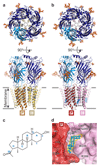Structural basis for GABAA receptor potentiation by neurosteroids
- PMID: 28991263
- PMCID: PMC6166781
- DOI: 10.1038/nsmb.3484
Structural basis for GABAA receptor potentiation by neurosteroids
Abstract
Type A γ-aminobutyric acid receptors (GABAARs) are the principal mediators of inhibitory neurotransmission in the human brain. Endogenous neurosteroids interact with GABAARs to regulate acute and chronic anxiety and are potent sedative, analgesic, anticonvulsant and anesthetic agents. Their mode of binding and mechanism of receptor potentiation, however, remain unknown. Here we report crystal structures of a chimeric GABAAR construct in apo and pregnanolone-bound states. The neurosteroid-binding site is mechanically coupled to the helices lining the ion channel pore and modulates the desensitization-gate conformation. We demonstrate that the equivalent site is responsible for physiological, heteromeric GABAAR potentiation and explain the contrasting modulatory properties of 3a versus 3b neurosteroid epimers. These results illustrate how peripheral lipid ligands can regulate the desensitization gate of GABAARs, a process of broad relevance to pentameric ligand-gated ion channels.
Conflict of interest statement
The authors declare no competing financial interests.
Figures






Similar articles
-
Structural basis of neurosteroid anesthetic action on GABAA receptors.Nat Commun. 2018 Sep 28;9(1):3972. doi: 10.1038/s41467-018-06361-4. Nat Commun. 2018. PMID: 30266951 Free PMC article.
-
Crystal structures of a GABAA-receptor chimera reveal new endogenous neurosteroid-binding sites.Nat Struct Mol Biol. 2017 Nov;24(11):977-985. doi: 10.1038/nsmb.3477. Epub 2017 Oct 2. Nat Struct Mol Biol. 2017. PMID: 28967882 Free PMC article.
-
Structure and dynamics of neurosteroid binding to the α1β2γ2 GABAA receptor.J Steroid Biochem Mol Biol. 2018 Sep;182:72-80. doi: 10.1016/j.jsbmb.2018.04.012. Epub 2018 Apr 26. J Steroid Biochem Mol Biol. 2018. PMID: 29705269
-
Inhibitory neurosteroids and the GABAA receptor.Adv Pharmacol. 2015;72:165-87. doi: 10.1016/bs.apha.2014.10.006. Epub 2014 Dec 4. Adv Pharmacol. 2015. PMID: 25600370 Review.
-
In Search of GABAA Receptor's Neurosteroid Binding Sites.J Med Chem. 2019 Jun 13;62(11):5250-5260. doi: 10.1021/acs.jmedchem.8b01400. Epub 2018 Dec 31. J Med Chem. 2019. PMID: 30566352 Review.
Cited by
-
Site-specific effects of neurosteroids on GABAA receptor activation and desensitization.Elife. 2020 Sep 21;9:e55331. doi: 10.7554/eLife.55331. Elife. 2020. PMID: 32955433 Free PMC article.
-
Structure of a human synaptic GABAA receptor.Nature. 2018 Jul;559(7712):67-72. doi: 10.1038/s41586-018-0255-3. Epub 2018 Jun 27. Nature. 2018. PMID: 29950725 Free PMC article.
-
The molecular determinants of neurosteroid binding in the GABA(A) receptor.J Steroid Biochem Mol Biol. 2019 Sep;192:105383. doi: 10.1016/j.jsbmb.2019.105383. Epub 2019 May 28. J Steroid Biochem Mol Biol. 2019. PMID: 31150831 Free PMC article.
-
A half century of γ-aminobutyric acid.Brain Neurosci Adv. 2019 Nov 27;3:2398212819858249. doi: 10.1177/2398212819858249. eCollection 2019 Jan-Dec. Brain Neurosci Adv. 2019. PMID: 32166183 Free PMC article. Review.
-
Molecular Mingling: Multimodal Predictions of Ligand Promiscuity in Pentameric Ligand-Gated Ion Channels.Front Mol Biosci. 2022 May 9;9:860246. doi: 10.3389/fmolb.2022.860246. eCollection 2022. Front Mol Biosci. 2022. PMID: 35615739 Free PMC article.
References
-
- Nemecz A, Prevost MS, Menny A, Corringer PJ. Emerging Molecular Mechanisms of Signal Transduction in Pentameric Ligand-Gated Ion Channels. Neuron. 2016;90:452–70. - PubMed
-
- Miller PS, Smart TG. Binding, activation and modulation of Cys-loop receptors. Trends Pharmacol Sci. 2010;31:161–74. - PubMed
-
- Hosie AM, Wilkins ME, da Silva HM, Smart TG. Endogenous neurosteroids regulate GABAA receptors through two discrete transmembrane sites. Nature. 2006;444:486–9. - PubMed
-
- Majewska MD, Harrison NL, Schwartz RD, Barker JL, Paul SM. Steroid hormone metabolites are barbiturate-like modulators of the GABA receptor. Science. 1986;232:1004–7. - PubMed
MeSH terms
Substances
Grants and funding
LinkOut - more resources
Full Text Sources
Other Literature Sources

